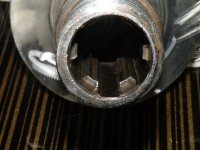Mark Rand
Diamond
- Joined
- Jul 9, 2007
- Location
- UK Rugby Warwickshire
In the next few days I'll be making a replacement for the hollow splined shaft that drives the spindle on my Beaver milling machine. The spindle has got 9° of slop in the splines, 98% of it in the female, driving spline and this makes for hard work when using any larger end mills or shell mills. I've got two questions that folks probably know the answers to:-
PS:- Here's the original. The original broached dimentions are still visible in the slight lands either side of the spline teeth!

- The spindle is hard, but the current hollow splined shaft that drives it appears to be dead soft. I'm going to be making the replacement from EN24T==4340PH. Might it be a good idea to get this gas nitrided to take the surface hardness up from about 34HRC to 50HRC. There's not a lot of sliding motion on a mill's splines, but I don't know if it's normal to have both parts hardened.
- Is there any benefit at all, in having a close fit on the inside or outside of the splines if you are aiming at as little backlash as possible so the sides of the splines ought to centre the two shafts?
PS:- Here's the original. The original broached dimentions are still visible in the slight lands either side of the spline teeth!



 .
.